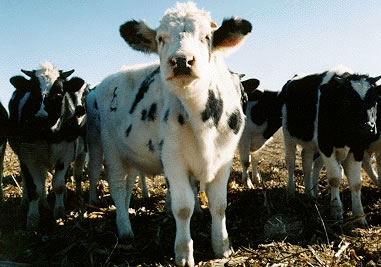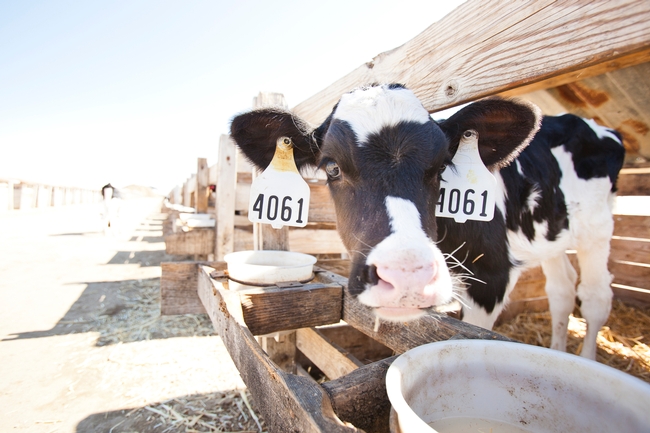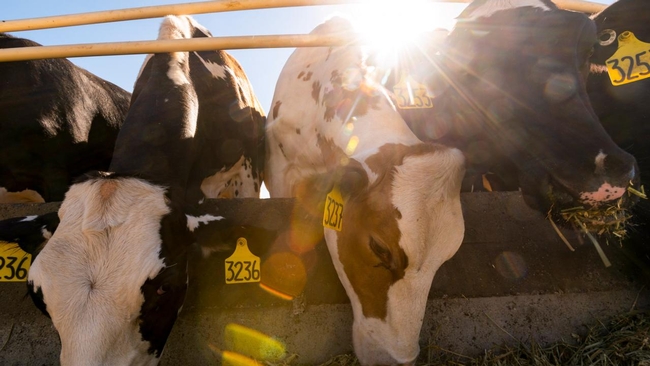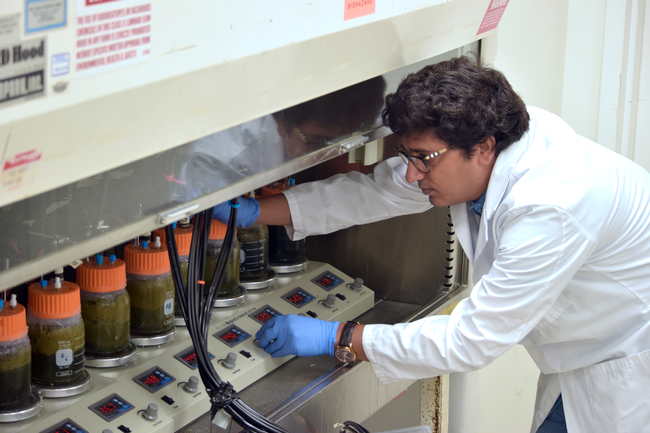Posts Tagged: methane
Report: California on path to significant dairy methane reduction
Researchers say dairy farms on track to achieve full 40% reduction goal by 2030
The California Dairy Research Foundation and University of California, Davis CLEAR Center announced on Dec. 14 the release of a new analysis of methane reduction progress titled "Meeting the Call: How California is Pioneering a Pathway to Significant Dairy Sector Methane Reduction." The paper, authored by researchers at UC Davis affiliated with UC Agriculture and Natural Resources, concludes that efforts are on track to achieve the state's world-leading target for reducing dairy methane emissions by 40% by 2030.
The report, written by distinguished professors of livestock emissions and agricultural economics, takes a comprehensive look at progress and projections, expanding upon the analysis of progress previously conducted by the California Air Resources Board. By documenting achievements to date, additional reduction efforts already funded, historic and current economic trends, and the projected availability of new solutions, the analysis lays out a workable path toward meeting California's goal. The pathway shows that California dairy farms are on track to achieve the full 40% dairy methane reduction goal and will reach “climate neutrality” by 2030. Climate neutrality is the point in which no additional warming is added to the atmosphere.
“This analysis shows that California's dairy sector is well on its way to achieving the target that was established by SB 1383 in 2016,” said CDRF's Executive Director Denise Mullinax. “With much important work still ahead, a clear understanding of this pathway helps dairy farmers, policy makers, researchers, and other partners make decisions to strategically press forward.”
The report outlines the need for continued implementation of California's four-part strategy for dairy methane reduction: farm efficiency and herd attrition, methane avoidance (alternative manure management), methane capture and utilization (digesters), and enteric methane reduction. Continued alignment of state and federal climate-smart agricultural approaches and incentives will also be critical to maintaining progress.
"Milk demand is growing, and California is among the world's low-cost suppliers of dairy products. It follows that effective California policy to reduce dairy greenhouse gas emissions must recognize that measures that cause milk production to exit the state do not mitigate global climate change," said study co-author Daniel Sumner, Distinguished Professor in the Department of Agriculture and Resource Economics at UC Davis. "Therefore, measures to help off-set mitigation costs, provide positive incentives for adoption of low-cost emission-reducing practices, and help stimulate innovation in methane reduction, are the economically efficient approaches."
The paper recognizes that enteric methane from the dairy and other livestock sectors is a significant source of greenhouse gas emissions in the U.S. and California. Several feed additives are expected to become commercially available in the next several years, which could be used to reduce enteric methane emissions from California's dairy herd.
“Adoption of enteric feed additives will become a valuable tool for dairy value chains to meet their greenhouse gas reduction goals,” said co-author and professor Ermias Kebreab, associate dean of global engagement and director of the World Food Center at UC Davis. “While this report provides only a broad overview of some of the most promising solutions, there is an incredible amount of research being conducted at UC Davis, nationally and internationally. The dairy industry, global food companies, state and federal agencies, and others continue to invest heavily in supporting enteric mitigation research efforts.”
The report finds that methane reductions from California's programs and projects in place today, coupled with the implementation of a moderate feed additive strategy to reduce enteric emissions, is on track to reduce between 7.61 to 10.59 million metric tons of methane (CO2e) by 2030, all from the dairy sector alone.
The collective investment in California's dairy methane reduction effort — from public and private funding — now exceeds $2 billion and counting. The California dairy sector, in coordination with the California Department of Food and Agriculture, was recently awarded up to $85 million by the United States Department of Agriculture under the Partnerships for Climate-Smart Commodities. The funding will leverage additional matching state funds and private capital investments, for a total of more than $300 million in new investment.
“It is important to highlight California's investments and success to date as an example of what is possible within the global livestock sector,” said co-author Frank Mitloehner, UC Davis animal science professor and air quality specialist in Cooperative Extension, and director of the UC Davis CLEAR Center. “California dairy farmers have demonstrated tremendous progress toward the state's methane reduction goal over the past several years. Given the short-lived nature of methane, this rapid reduction is an important contribution to the global effort to quickly limit climate warming.”
The author's analysis was prepared by Gladstein Neandross & Associates (GNA). Funding was provided by CDRF as part of its work to support an innovative and sustainable California dairy industry.
Innovating dairy digester research
California leads the nation in agricultural production, producing nearly all the nation's leafy green vegetables, most nut and fruit varieties, and is ranked first in egg and dairy production.
What that means is that California also produces a lot of agricultural waste materials, including lots of manure.
Historically these waste materials have been used as a rich source of compost. However, researchers at UC Cooperative Extension are researching innovative uses for this material.
Dr. Pramod Pandey, a faculty member and Cooperative Extension specialist at the UC Davis School of Veterinary Medicine, focuses on better ways to manage waste material for both large and small farms. Dr. Pandey researches how to convert the organic matter in manure and other waste materials into a renewable energy source that can be used to power our state.
Converting manure to renewable energy
California gets over 27% of its energy from renewable resources like solar wind, and hydroelectric. Our goal is 50% renewable energy by 2030. California is taking steps towards this goal by building a network of dairy digesters which use bacteria to break down dairy manure and convert it into biogas. Clean burning fuels, such as biogas, are a sustainable source for generating energy because when they are burned, harmful by products are not produced.
Big bonus
A bonus is that the solid material left after the digesters have done their job is a fertilizer that can be used to grow the fruits, vegetables and nuts that our state is famous for. This type of fertilizer contains nutrients that are more readily available for plants because the digestion process breaks up organic materials more efficiently than traditional composting. The digestion process also helps reduce the number of harmful bacteria found in manure, making it much safer for use on plants grown for human food.
California leading in discovery and innovation
When we think about where agriculture has been and where it is going, innovation, efficiency and environmental sustainability are hallmarks of our approach in California. People like Dr. Pandey are driving forward research and technology to minimize the impact of agriculture production on the environment. When we think about where agriculture has been and where it is going, innovation, efficiency and environmental sustainability are hallmarks of our approach in California. His multidisciplinary approach to solving this complex problem of agricultural waste materials and water/air quality helps improve the economic wellbeing of farmers, and benefits Californians by providing nutrients for safe, healthy, and nutritious food.
While the importance of California's agriculture might be huge, its footprint on the environment doesn't have to be, and it is researchers like Dr. Pramod Pandey who are ensuring our state leads in discovery and innovation for many harvests to come.
Heather Johnson, Instructional Systems Designer, Gregory Wlasiuk, E-Learning Curriculum Designer, and Dr. Sara Garcia, Project Scientist, with the Western Institute for Food Safety and Security at the University of California, Davis, provided the script for the video which was used in this story. View Heather, Sara and Greg's filming and editing skills in the video below. Greg provides the narration.
Pollution regulations stymie dairy electricity generation
For Central Valley dairies, conflicting laws are making it hard to generate green electricity from dairy waste, according to an article this week in the Los Angeles Times.
In order to reduce emissions of methane - a greenhouse gas - some dairy operators have installed methane digesters that convert the methane into electricity.
However, the process produces nitrogen oxides (NOx), which react with volatile organic compounds to create ozone, a significant air pollution problem in the San Joaquin Valley. NOx levels for the valley, a region with air pollution among the most severe in the country, is set by federal officials and enforced by the San Joaquin Valley Air Pollution Control District.
The district is requiring expensive modifications on digesters, which in some cases shuts the equipment down altogether. Air district officials told the LA Times they're just doing their jobs. "Combating smog, not climate change, is the agency's mission," Times reporter P.J. Huffstutter wrote.
Modesto dairy operator John Fiscalini spent hundreds of thousands of dollars on a catalytic converter and other filtering equipment to meet the air district's limit of 11 parts per million of NOx for his digester system.UC Davis Cooperative Extension animal scientist Frank Mitloehner told the Times that works out to equal the emissions of 26 cars for every 1,000 cows.
"They have a point. I want clean air," Visalia dairy farmer Ron Koetsier was quoted in the story. "But it doesn't make financial sense for me keep doing this. I don't see how they can turn methane gas into electricity in California, given these rules."

Dairy cow in California.
UC helps Marin dairy operators clear the air
UC Cooperative Extension provided Marin ranchers and dairy operators exposure at a two-hour workshop Feb. 2 to the latest conservation practices that can help the agriculture industry reduce its environmental impacts and increase farm and ranch energy efficiency.
In addition to local farmers, reporter Rob Rogers was at the event collecting information for an article published in the Marin Independent Journal yesterday.Rogers reported that cows produce a smaller percentage of greenhouse gases in the United States and Europe than in other nations, where farming is a larger part of the economy, and where it's practiced less efficiently. According to the United Nations, livestock produce about 18 percent of the world's greenhouse gasses. In the U.S., livestock is responsible for just 5.8 percent of total greenhouse gas emissions.
Workshop speaker Frank Mitloehner, UC Davis air quality specialist, said research shows that it is cows - not waste storage lagoons - that emit most methane and nitrous oxide on dairies.
"Lagoon waste is so heavily diluted that it's a smaller factor than fresh waste," Mitloehner was quoted in the story.
He offered solutions that may not sit well with organic producers:
-
Produce more milk with fewer cows by increasing efficiency.
-
Cut back on grass-fed cattle, which, because of extra roughage, produce more methane.
Albert Strauss, an organic dairy farmer who also spoke at the meeting, noted that reducing cow emissions is only part of the environmental picture. One option for reducing dairy emissions is converting waste into energy with a methane digester. Using this technology, the Strauss operation meets its own energy needs and will soon be selling extra energy back to PG&E, the article said.

dairycow



